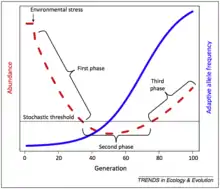Evolutionary rescue
Evolutionary rescue is a process by which a population—that would have gone extinct in the absence of evolution—persists due to natural selection acting on heritable variation.[1][2] The term was first used in 1995 by Gomulkiewicz and Holt [3] in the context of a sudden environmental change, but the process was studied long before in the context of continuous environmental change[4] and, especially, drug resistance evolution.[5]
Theoretical framework
After a sudden change in the environment, evolutionary rescue is predicted to create a U-shaped curve of population dynamics, as the original genotypes, which are unable to replace themselves, are replaced by genotypes that are able to increase in numbers.[3] In a continuously changing environment, evolutionary rescue is predicted to appear as a stable lag of the mean trait value behind a moving environmental optimum, where the rate of evolution and rate of change in the environment are equal.[6] The theory has been reviewed by Alexander et al in 2014 [7] and continues to grow rapidly, adding both genetic and ecological complexity.

Evolutionary rescue is distinct from demographic rescue, where a population is sustained by continuous migration from elsewhere, without the need for evolution.[9] On the other hand, genetic rescue, where a population persists because of migration that reduces inbreeding depression, can be thought of a special case of evolutionary rescue (but see [8]).
Empirical evidence
Evolutionary rescue has been demonstrated in many different experimental evolution studies,[1] such as yeast evolving to tolerate previously lethal salt concentrations.[10] There are also a large number of examples of evolutionary rescue in the wild,[1] in the forms of drug resistance, herbicide resistance,[11] other types of pesticide resistance, and genetic rescue.
References
- Bell, G (2017). "Evolutionary rescue". Annual Review of Ecology, Evolution, and Systematics. 48 (1): 201–207. doi:10.1146/annurev-ecolsys-110316-023011.
- Gonzalez, Andrew (2012). "Evolutionary rescue; an emerging focus at the intersection between ecology and evolution". Philosophical Transactions of the Royal Society B.
- Gomulkiewicz, R; Holt, R (1995). "When does natural selection save a population from extinction?". Evolution. 49 (1): 201–207. doi:10.1111/j.1558-5646.1995.tb05971.x. PMID 28593677. S2CID 29819056.
- Pease, C; Lande, R; Bull, J (1989). "A Model of Population Growth, Dispersal and Evolution in a Changing Environment". Ecology. 70 (6): 1657–1664. doi:10.2307/1938100. JSTOR 1938100.
- Levy, S; Marshall, B (2004). "Antibacterial resistance worldwide: causes, challenges and responses". Nature Medicine. 10 (12 Suppl): S122–S129. doi:10.1038/nm1145. PMID 15577930.
- Burger, B; Lynch, M (1995). "Evolution and extinction in a changing environment: a quantitative-genetic analysis". Evolution. 49 (1): 151–163. doi:10.2307/2410301. JSTOR 2410301. PMID 28593664.
- Alexander, H; Martin, G; Martin, O; Bonhoeffer, S (2014). "Evolutionary rescue: linking theory for conservation and medicine". Evolutionary Applications. 7 (10): 1161–1179. doi:10.1111/eva.12221. PMC 4275089. PMID 25558278.
- Carlson, S; Cunningham, C; Westley, P (2014). "Evolutionary rescue in a changing world". Trends in Ecology & Evolution. 29 (9): 521–530. doi:10.1016/j.tree.2014.06.005. PMID 25038023.
- Brown, J; Kodric-Brown, A (1977). "Turnover rates in insular biogeography: effect of immigration on extinction". Ecology. 58 (2): 445–449. doi:10.2307/1935620. JSTOR 1935620.
- Bell, G; Gonzalez, A (2009). "Evolutionary rescue can prevent extinction following environmental change". Ecology Letters. 12 (9): 942–948. doi:10.1111/j.1461-0248.2009.01350.x. PMID 19659574.
- Kreiner, Julia M.; Stinchcombe, John R.; Wright, Stephen I. (2018-04-29). "Population Genomics of Herbicide Resistance: Adaptation via Evolutionary Rescue". Annual Review of Plant Biology. Annual Reviews. 69 (1): 611–635. doi:10.1146/annurev-arplant-042817-040038. ISSN 1543-5008. PMID 29140727. S2CID 25489201.